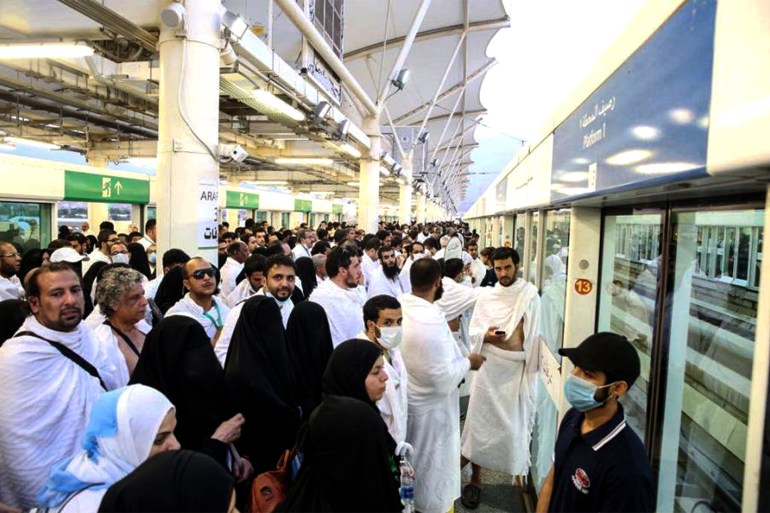Two years after it stopped serving the pilgrims due to the reduction in the number of pilgrims due to the Corona virus, this year the holy sites train returns to work again to transport pilgrims between Makkah Al-Mukarramah and the sites of Mina, Arafa and Muzdalifah.
The Mashaer Train is a railway linking Makkah with the Holy Sites. It consists of 17 trains, comprising 204 cars, and each car can accommodate 300 passengers, with a track length of 18 km, and an altitude of 8-10 meters above the ground.
The implementation of the project began in 2008 at a total cost of 6 billion and 650 million Saudi riyals (US$3.75 riyals) and was opened in 2010 with a capacity of 72,000 people, and contains 9 stations, with a length of 300 meters for each station.
The objective of the Mashaer Train is to reduce traffic congestion, ease transportation between the feelings, and safety of the environment, as the train contributed to dispensing with 50,000 vehicles and buses upon entering the Holy Sites, in addition to the need to use the ground spaces to build tents to accommodate a larger number of pilgrims.
The train includes crowd control and monitoring systems (Saudi Press Agency)
Automatic Control
The train operates according to an automated system that is controlled by a control center, and its speed ranges between 80-120 kilometers per hour. It also includes crowd control and crowd control systems, in addition to a number of systems necessary for emergency, rescue, and firefighting.
The project includes 9 stations elevated from the ground with a length of 300 meters for each station. The train berths are accessed by ramps, elevators, ordinary and electric stairs, automatic gates separating the train, loading areas and waiting areas, and is characterized by remote sensing technology to identify ticket holders that are sold to companies and institutions. Crowds are mobilized to the stations on specific paths to the waiting areas below the stations, which can accommodate more than 3,000 pilgrims.
The train passes through the stations distributed in Arafat, Muzdalifah, and Mina, with 3 stations for each Masha’ar, where the train passes through 3 different stations in the Arafat area, and then passes by 3 other stations in Muzdalifah, then stops at the first station at the first Mashari’ of Mina, then in the middle, while its station arrives. The last to the fourth floor in the Jamarat Bridge facility.
Al Mashaer Train track is 18 km (Saudi Press Agency)
Crowd Control
The crowd control project is one of the organizational projects that provide tangible efforts at the holy sites train stations, and aims to control, sort and organize the movement of pilgrims on the paths leading to the gates of the train stations, sorting ticket holders at the train gates, controlling and organizing the movement of pilgrims under the train stations, and facilitating their movement to ascend. To train station platforms via elevators and stairs, protect station fences and gates, and prevent sleeping inside stations.
This comes in conjunction with the first smart application to be implemented in Hajj, which was launched by the Makkah Region Development Authority, to link pilgrims with the crowd control center on the Holy Sites train, with the aim of organizing their movement from the camps until their arrival on the train, according to their timetables.
The application serves as a link between the leaders of the groups of pilgrims and the control room of the Crowd Control Center, and it contains the schedule for grouping pilgrims, and it also provides the opportunity for the relevant authorities to prepare for grouping according to the schedule specified for each group.
The train passes through the stations distributed in Arafat, Muzdalifah and Mina, with 3 stations for each area (Saudi Press Agency)
Operating plans
The Saudi Railways Company "SAR", which operates the Mashaer Railway, said in a statement that it had started its preparations to operate the train in this year's Hajj season from an early age, and had completed all routine and corrective maintenance work, in addition to a number of necessary improvement projects before starting operations.
She added that the operations are divided into 3 basic stages: the pre-operation stage, the trial run stage, which includes (4) simulators for operating the Hajj and the unified training hypothesis with all parties involved in the operation to determine the final preparations, leading to the actual operation during the Hajj season.

